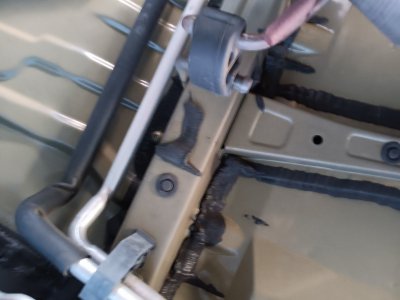Hi. I was wondering what all the holes in the frame under a Toyota Sienna are for. I realize that the large oblong ones are for tie points for shipping the cars to the dealer, and they are plugged by the dealer before the sale. That shields all my search efforts for the smaller holes. The 3/8" holes look like they are for M6 rivet nuts for putting in a catalytic converter shield, but they are in the wrong place. There are also 1/2" holes that look too big for rivnuts. They seem to be in more convenient locations. Both sizes of round holes are plugged with easily removed rubber plugs. Are these for attaching something special? Is it safe to use them for attaching things of our own?
-
Welcome back Guest! Did you know you can mentor other members here at H-M? If not, please check out our Relaunch of Hobby Machinist Mentoring Program!
You are using an out of date browser. It may not display this or other websites correctly.
You should upgrade or use an alternative browser.
You should upgrade or use an alternative browser.
Toyota undercarriage frame holes
- Thread starter ericc
- Start date
- Joined
- Aug 9, 2023
- Messages
- 589
Pictures would help greatly.
- Joined
- Apr 24, 2022
- Messages
- 123
Yep. The great big holes are usually in the low areas of the floor pan, and are drain holes for when the unibody is run through a vat of e-coat (Electrophoretic applied primer)
E-Coating Process
E-Coating Process
Those holes have all kinds of reasons. There are tie down points, there are drains, there are vents, there are fixturing holes for building the vehicle, there are "engineered weak spots" so that the vehicle crumples in the CORRECT place during a collision from various angles to keep the cabin as intact as practicable, there are accessory/option mounting points that may not necessarily be equipped, there may be add on equipment provisions... All kinds of reasons.
The plugs and open holes- If they're factory "plugged" (or like the two hooks, plugged when not in use), keep 'em that way. If they're factory "open", keep 'em that way. The decision on whether or not to add the plug is about controlling the weather inside of an enclosed space. In other words, corrosion control. While it doesn't seem so here in the salt belt, they actually put a lot of work into that, making sure the area "breathes" enough, doesn't collect much dirt, debris, or other moisture holding junk, and generally doesn't stay damp and dirty for long enough to cause structural failures.
The plugs and open holes- If they're factory "plugged" (or like the two hooks, plugged when not in use), keep 'em that way. If they're factory "open", keep 'em that way. The decision on whether or not to add the plug is about controlling the weather inside of an enclosed space. In other words, corrosion control. While it doesn't seem so here in the salt belt, they actually put a lot of work into that, making sure the area "breathes" enough, doesn't collect much dirt, debris, or other moisture holding junk, and generally doesn't stay damp and dirty for long enough to cause structural failures.





